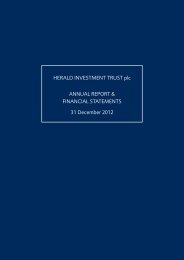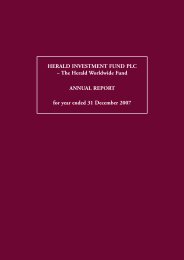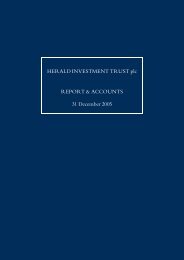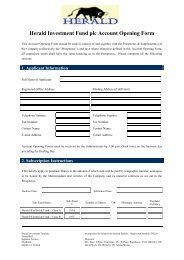HERALD INVESTMENT TRUST plc ANNUAL REPORT ...
HERALD INVESTMENT TRUST plc ANNUAL REPORT ...
HERALD INVESTMENT TRUST plc ANNUAL REPORT ...
Create successful ePaper yourself
Turn your PDF publications into a flip-book with our unique Google optimized e-Paper software.
DIRECTORS’ <strong>REPORT</strong><br />
The Directors present their Report together with the financial statements of the Company for the year to 31<br />
December 2010.<br />
Business Review<br />
Business and Status<br />
The Company is an investment company within the meaning of Section 833 of the Companies Act 2006.<br />
The Company carries on business as an investment trust. It was approved by HM Revenue & Customs as<br />
an investment trust under Section 842 of the Income and Corporation Taxes Act 1988 for the year ended 31<br />
December 2009, subject to matters that may arise from any subsequent enquiry by HM Revenue & Customs<br />
into the Company’s tax return. In the opinion of the Directors the Company has conducted its affairs so as to<br />
enable it to continue to obtain such approval and it will continue to seek approval under Section 1158 of the<br />
Corporation Tax Act 2010 (formerly Section 842 ICTA 1988) each year.<br />
Objective<br />
Herald’s objective is to achieve capital appreciation through investments in smaller quoted companies, in the<br />
areas of telecommunications, multi-media and technology (TMT). Investments may be made across the world.<br />
The business activities of investee companies will include information technology, broadcasting, printing and<br />
publishing and the supply of equipment and services to these companies.<br />
Investment Policy<br />
While the policy is global investment in the above target areas the approach is to construct a diversified portfolio<br />
through the identification of individual companies which offer long term growth potential, typically over a five<br />
year horizon or more. The portfolio is actively managed and does not seek to track any comparative index.<br />
With a remit to invest in smaller companies with market capitalisation generally below £1bn, there tends to be<br />
a correlation with the performance of smaller companies, as well as those of the technology sector. A degree<br />
of volatility relative to the overall market should be expected.<br />
The risk associated with the illiquidity of smaller companies is reduced by generally restricting the stake<br />
in any one company to less than 10% of the shares in issue. A number of investments are in early stage<br />
companies, which have a higher stock specific risk but the potential for above average growth. Stock specific<br />
risk is reduced by having a diversified portfolio of over 200 holdings. In addition, to contain the risk of any<br />
one holding, the Manager generally takes profits when a holding reaches more than 5% of the portfolio. The<br />
Manager actively manages the exposure within the constraint that illiquid positions cannot be traded for short<br />
term movements.<br />
The Company has a policy not to invest more than 15% of gross assets in other UK listed investment companies.<br />
From time to time, fixed interest holdings, non equity or unlisted investments may be held on an opportunistic<br />
basis.<br />
The Company recognises the long term advantages of gearing and has a maximum gearing limit of 50% of<br />
net assets. Borrowings are invested primarily in equity markets but the Manager is entitled to invest in other<br />
securities in the companies in the target areas when it is considered that the investment grounds merit the<br />
Company taking a geared position. The Board’s intention is to gear the portfolio when appropriate with<br />
borrowings to around 30% of net assets. Gearing levels are monitored closely by the Manager and reviewed<br />
by Directors at each Board Meeting.<br />
The Company may use derivatives which will be principally, but not exclusively, for the purpose of efficient<br />
portfolio management (i.e. for the purpose of reducing, transferring or eliminating investment risk in its<br />
investments, including protection against currency risk).<br />
A detailed analysis of the Company’s investment portfolio is set out on pages 16 to 20 and in the Investment<br />
Manager’s Report.<br />
Performance<br />
At each Board meeting, the Directors consider a number of performance measures to assess the Company’s<br />
success in achieving its objectives.<br />
The key performance indicators (KPIs) used to measure the progress and performance of the Company over<br />
time are established industry measures and are as follows:<br />
▯▯<br />
▯▯<br />
▯▯<br />
▯▯<br />
the movement in net asset value per ordinary share compared to the comparative index;<br />
the movement in the share price;<br />
the discount; and<br />
the total expense ratio.<br />
22








